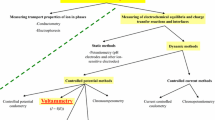Abstract
THE spray-drop method of Williams and Backus1,2 is a valuable technique in electron microscopy for the estimation of virus concentrations. A statistical analysis was described in the original papers3. In 1958 we showed4 that this analysis was valid and gave a test to check that in any estimation the pairs of numbers used were unlikely to contain variations due to causes other than purely random ones. We pointed out that the ratio between the number of virus (Vi) and the number of latex (Li) in the ith drop can be expected to vary between one drop and the next for two reasons. There is the variation due to random movements of the particles, both virus and latex, in suspensions at ordinary temperatures which introduces an uncertainty into whether a particle is in or not in a drop at the instant of formation. This introduces a variation in the numbers of particles expected in drops of the same size from a uniformly mixed suspension. It will have a Poisson distribution and has been termed by us inherent variation. The second reason is due to experimental factors—inadequate mixing, contamination during spraying, aggregation of particles, etc., and these have been termed induced variations. Our test shows whether the pairs of numbers obtained from a series of drops contain variations in excess of that which would be expected from the inherent variation alone. This test does not make any assumption about drop size and may be applied to a collection of droplets of any size distribution.
Similar content being viewed by others
References
Williams, R. C., and Backus, R. C., J. Amer. Chem. Soc., 71, 4052 (1949).
Backus, R. C., and Williams, R. C., J. App. phys., 21, 11 (1950).
Luria, S. E., Williams, R. C., and Backus, R. C., J. Bact., 61, 179 (1951).
Williamson, K. I., and Taylor, W. B., Brit. J. App. Phys., 9, 264 (1958).
Opfell, J. B., Nature, 186, 822 (1960).
Watson, D. H., Biochim. Biophys. Acta, 61, 321 (1962).
Bresse, jun., S. S., and Trautman, R., Virology, 10, 57 (1960).
Crocker, T. T., and Bennett, B. M., J. Immunol., 69, 183 (1952).
Author information
Authors and Affiliations
Rights and permissions
About this article
Cite this article
WILLIAMSON, K., TAYLOR, W. Analysis of Spray-drop Data. Nature 200, 813–814 (1963). https://doi.org/10.1038/200813a0
Issue Date:
DOI: https://doi.org/10.1038/200813a0
- Springer Nature Limited





